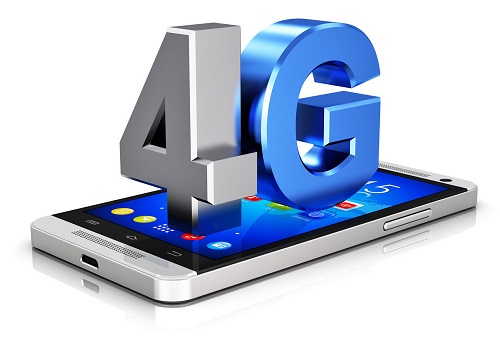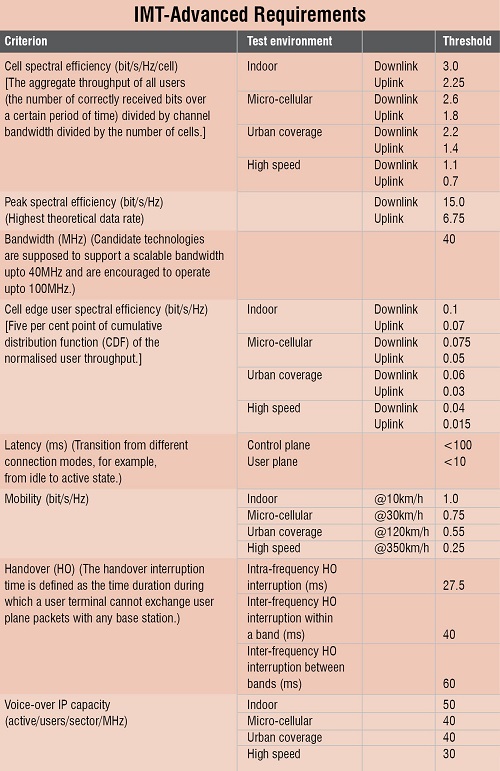With the objective to fulfil the 4G criteria of 1Gbps for stationary reception and 100Mbps for mobile reception, many wireless technologies are rapidly progressing to meet and surpass 4G requirements.
4G is the fourth generation of mobile wireless standards—a successor to the 3G and 2G families of standards—and is expected to provide a comprehensive and secure all-IP based mobile broadband solution to laptop/computer wireless modems, smartphones and other mobile devices. With the help of such promising next-generation technology, facilities such as ultra-broadband Internet access, IP telephony, gaming services, high-resolution streamed multimedia [multimedia messaging service, video chat, video conferencing, mobile TV and HDTV (high-definition TV)] may be provided to users. The system will allow global roaming, higher rate of data transfer with much higher and tight security and safety features, all at a lower cost.
In 2009, the International Telecommunication Union—Radiocommunication (ITU-R) group specified the international mobile telecommunications-Advanced (IMT-Advanced) requirement s for 4G standards, setting peak speed requirements for 4G services at 100Mbps for high-mobility communication and 1Gbps for low-mobility or fixed communication. As the most advanced technologies currently defined for global wireless mobile broadband communications, IMT-Advanced is considered as 4G, although it is recognised that this term may also be applied to the forerunners and other evolved 3G technologies providing a substantial level of improvement in performance and capabilities with respect to initial third-generation systems.
s for 4G standards, setting peak speed requirements for 4G services at 100Mbps for high-mobility communication and 1Gbps for low-mobility or fixed communication. As the most advanced technologies currently defined for global wireless mobile broadband communications, IMT-Advanced is considered as 4G, although it is recognised that this term may also be applied to the forerunners and other evolved 3G technologies providing a substantial level of improvement in performance and capabilities with respect to initial third-generation systems.
IMT-Advanced or 4G systems are mobile systems that include new capabilities of IMT that go beyond those of IMT-2000. Such systems provide access to a wide range of telecommunication services including advanced mobile services, supported by mobile and fixed networks, which are increasingly packet based. IMT-Advanced systems support low to high mobility applications and a wide range of data rates in accordance with user and service demands in multiple user environments. Moreover, IMT‑Advanced has capabilities for high-quality multimedia applications within a wide range of services and platforms, providing a significant improvement in performance and quality of service. These features enable IMT-Advanced to address evolving user needs.
Scanning the mobile generations
There are no specific measures to consider the years of generations. Rather, generations are measured on the basis of significant stages or considerable innovations in standards and applications. Significant stages in the evolution of mobile radio systems are referred to in terms of generations: 0th generation or 0G, first generation or 1G, second generation or 2G, third generation or 3G, and fourth generation or 4G. Reviewing previous wireless generations will help put 4G in context.

0G systems preceded modern mobile telephony and are referred to as mobile radio telephone systems. Mobile radio service originated with Bell Systems in 1946. Technologies used in pre-mobile systems included push-to-talk (PTT or manual), mobile telephone system (MTS), mobile telephony system A/B/C/D (MTA/B/C/D), offentlig landmobil telefoni (OLT), improved mobile telephone service (IMTS) and advanced mobile telephone system (AMTS).
The 1G of mobile generation came in 1980s, offering for the first time a relatively affordable mobile wireless telephony service. 1G was characterised by a multiplicity of incompatible regional analogue standards such as analogue advanced mobile phone system (AMPS)—North American standard in mobile band (800MHz), total access communications system (TACS)—the UK-originated standard based on AMPS in 900MHz band, Nordic mobile telephony system (NMT)—Scandinavian standard in 450MHz and 900MHz bands, C-450—German standard in 450MHz band and Japanese total access communications system (JTACS)—Japanese standard in 900MHz band. These incompatible analogue standards kept the market fragmented, expensive and without national roaming facility.
In early 1990s, global system for mobile (GSM) communication, the first of the digital 2G, arrived to provide telephony plus text messaging and limited circuit-switched data services. For GSM, everything lined up—technology, demand, supply, pricing, value and delivery costs. The result remains an enormous international industry that in 15 years grew from nothing to being owned by more than half the people on the planet, revolutionising the way the world communicates.
2.5G, which stands for second and a half generation, is a mobile wireless technology developed in between its predecessor, 2G, and its successor, 3G. 2.5G is used to describe 2G systems that have implemented a packet-switched domain in addition to circuit-switched domain. Such a packet-switched base service is general packet radio service (GPRS) that can provide moderate-speed data rates from 56kbps to 114kbps using time division multiple access (TDMA) channels in the GSM system.
Another extension of GSM is 2.75G—enhanced data rates for GSM evolution (EDGE) or IMT-SC (single carrier) that is able to support both circuit-switched and packet-switched networks. EDGE can carry a bandwidth up to 236.8kbps for four timeslots (theoretical maximum is 473.6kbps for eight timeslots) in packet mode. The other main 2G system is code division multiple access (CDMA), which offers services similar to GSM but in different geographies.










